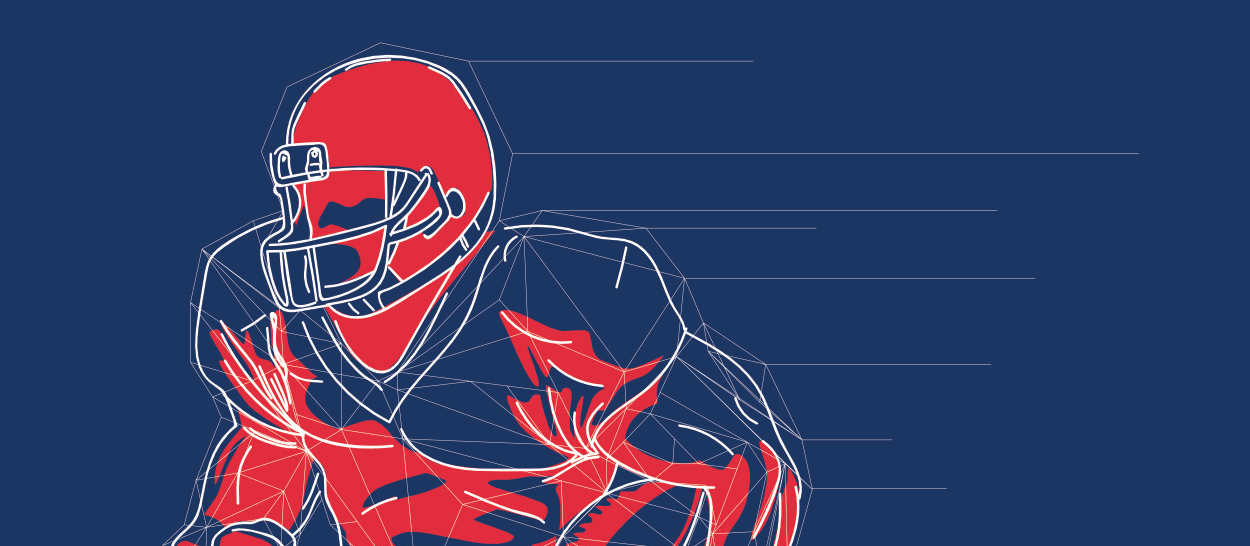This week, I will look for the point that last year's production still takes precedence and the point that the current season stats take over.
I almost cringe at times when I hear an announcer say a player's previous season's production just needs to be ignored. Nothing is more wrong. The player aged (and likely declined), but they don't completely change. Sure some players have change teams, coaches, offensive schemes, etc. Others have been hurt or are competing with a rookie. But last year still matters.
Time for some numbers.
Looking only at running backs and wide receivers, I considered the 1,000 players in each position group who had the most handoffs plus targets from 2000 to 2014 and found their average standard-scoring points per game for each season, their weekly average points at a season's start and their average points to end the season. With the three values, I found the following data:
• The r-squared (how well the data correlates) from the previous season compared to the rest of the remaining games.
• The r-squared from the season's first games compared to the rest of the remaining games.
• The r-squared of a linear
This week, I will look for the point that last year's production still takes precedence and the point that the current season stats take over.
I almost cringe at times when I hear an announcer say a player's previous season's production just needs to be ignored. Nothing is more wrong. The player aged (and likely declined), but they don't completely change. Sure some players have change teams, coaches, offensive schemes, etc. Others have been hurt or are competing with a rookie. But last year still matters.
Time for some numbers.
Looking only at running backs and wide receivers, I considered the 1,000 players in each position group who had the most handoffs plus targets from 2000 to 2014 and found their average standard-scoring points per game for each season, their weekly average points at a season's start and their average points to end the season. With the three values, I found the following data:
• The r-squared (how well the data correlates) from the previous season compared to the rest of the remaining games.
• The r-squared from the season's first games compared to the rest of the remaining games.
• The r-squared of a linear regression using the previous season's and season's first games compared to the rest of the remaining games.
• For the regression, the weighted percentage that should be given to the previous season's stats.
• For the regression, the weighted percentage that should be given to this early season's stats.
Now off to the running backs.
Running Backs
I will start with the results and then dissect them.
| PREV. SEASON AVG R2 | PREV. WK(s) AVG SCORE R2 | COMBINATION | PREV. YEAR% | CURRENT YEAR% | |
| 1 Week | 0.39 | 0.34 | 0.85 | 70.1% | 29.9% |
| 2 Weeks | 0.39 | 0.42 | 0.86 | 57.0% | 43.0% |
| 3 Weeks | 0.38 | 0.46 | 0.87 | 50.1% | 49.9% |
| 4 Weeks | 0.35 | 0.49 | 0.87 | 42.6% | 57.4% |
| 5 Weeks | 0.33 | 0.5 | 0.86 | 36.3% | 63.7% |
| 6 Weeks | 0.33 | 0.51 | 0.87 | 34.0% | 66.0% |
| 7 Weeks | 30.9% | 69.1% | |||
| 8 Weeks | 28.1% | 71.9% | |||
| 9 Weeks | 25.7% | 74.3% | |||
| 10 Weeks | 23.6% | 76.4% | |||
| 11 Weeks | 21.6% | 78.4% | |||
| 12 Weeks | 19.8% | 80.2% | |||
| 13 Weeks | 18.2% | 81.8% | |||
| 14 Weeks | 16.7% | 83.3% | |||
| 15 Weeks | 15.2% | 84.8% |
I ran the numbers for each of the first six weeks of data. The results are as expected. To start with, the previous season's data is more important, but the current stats take over rather quickly. When comparing the historic data to the future data, the correlations aren't the best with previous weeks' worth of data hitting an R-squared of .50 after three weeks.
Now, when both previous values are combined, the results look much better with R-squared values greater than .85. After Week 3, the two values are weighted 50-50 and then the current year's data begin to take precedence. The previous season still has some weight and doesn't go away.
With six weeks of data, I decided to project the rest of the season's weights.
Now, if someone wants to go full nerd, here is the equation to get a projected rest of season average stat:
Average points per week = (Average of Current Year)*(.2054*LN(Weeks Completed)+.2914)+(Average of previous season) *(1- (.2054*LN(Weeks Completed)+.2914) )
Finally, here are the top-12 running backs according to their average fantasy points this year.
| PLAYER | TEAM | AVG 2016 PTS | AVG 2015 PTS | PROJ (57/43) | RW PROJ | DIFF |
| DeAngelo Williams | PIT | 24.2 | 12.1 | 17.3 | 30.0 | 12.7 |
| Matt Forte | NYJ | 22.2 | 13.1 | 17.0 | 22.3 | 5.3 |
| C.J. Anderson | DEN | 20.6 | 8.0 | 13.4 | 18.1 | 4.7 |
| Spencer Ware | KC | 18.2 | 7.0 | 11.8 | 10.1 | -1.7 |
| Melvin Gordon | SD | 17.9 | 6.0 | 11.1 | 20.3 | 9.2 |
| Isaiah Crowell | CLE | 17.3 | 7.4 | 11.7 | 14.1 | 2.4 |
| DeMarco Murray | TEN | 17.1 | 9.6 | 12.8 | 12.6 | -0.2 |
| David Johnson | ARZ | 16.8 | 11.0 | 13.5 | 15.1 | 1.6 |
| LeGarrette Blount | NE | 15.7 | 9.7 | 12.3 | 17.2 | 4.9 |
| Theo Riddick | DET | 14.7 | 6.3 | 9.9 | 10.7 | 0.8 |
| Latavius Murray | OAK | 14.7 | 10.4 | 12.2 | 5.5 | -6.7 |
| Ryan Mathews | PHI | 14.6 | 8.5 | 11.1 | 17.0 | 5.9 |
With each running back, I have included their 2015 points, how the two values should be historically weighted and, for a little fun, our official weekly projections and the difference in the two projections. My weighted projections are the averages for the whole season, so on a week-to-week schedule, I would expect some players to be above and some below the weighted estimate.
In this instance, nine of 12 players are expected to outperform estimates. The average projected overshoot is 3.3 points. I will look at the results again next week (and maybe each additional week).
Enough of the running backs, now onto the wide receivers.
Wide receivers
For the results, I went one more week with the actual results before calculating a projection equation. The reason for the extra dataset was that I wanted another set of data after the in-season data precedence took over.
| PREV. SEASON AVG R2 | PREV. WK(s) AVG SCORE R2 | COMBINATION | PREV. YEAR% | CURRENT YEAR% | |
| 1 Week | 0.31 | 0.19 | 0.87 | 80.3% | 19.7% |
| 2 Weeks | 0.29 | 0.27 | 0.87 | 69.7% | 30.3% |
| 3 Weeks | 0.28 | 0.31 | 0.87 | 61.4% | 38.6% |
| 4 Weeks | 0.26 | 0.37 | 0.88 | 51.5% | 48.5% |
| 5 Weeks | 0.25 | 0.41 | 0.88 | 43.3% | 56.7% |
| 6 Weeks | 0.24 | 0.42 | 0.88 | 39.6% | 60.4% |
| 7 Weeks | 0.24 | 0.43 | 0.88 | 39.2% | 60.8% |
| 8 Weeks | 35.1% | 64.9% | |||
| 9 Weeks | 32.4% | 67.6% | |||
| 10 Weeks | 30.0% | 70.0% | |||
| 11 Weeks | 27.8% | 72.2% | |||
| 12 Weeks | 25.8% | 74.2% | |||
| 13 Weeks | 24.0% | 76.0% | |||
| 14 Weeks | 22.2% | 77.8% | |||
| 15 Weeks | 20.7% | 79.3% |
As stated above, the biggest difference between wide receivers and running backs is the extra time it takes for in-season data to become more relevant.
The crossover happens at Week 4, and the previous season's data stays important as the season progresses.
Like with the running backs, here is the ultimate nerd equation to figure out the weekly projection using previous values:
Average points per week = (Average of Current Year)*(.2305*LN(Weeks Completed)+.1692)+(Average of previous season) *(1- (.2305*LN(Weeks Completed)+.1692) )
Again, here is a look at the top-12 wide receivers over the first two weeks with their weight projected and official RotoWire projection.
| PLAYER | TEAM | AVG 2016 PTS | AVG 2015 PTS | PROJ (57/43) | RW PROJ | DIFF |
| Kelvin Benjamin | CAR | 19.0 | 8.0 | 11.3 | 15.1 | 3.8 |
| Willie Snead | NO | 17.3 | 7.8 | 10.7 | 12.4 | 1.7 |
| Stefon Diggs | MIN | 17.2 | 7.5 | 10.4 | 13.7 | 3.3 |
| Brandin Cooks | NO | 17.1 | 10.6 | 12.6 | 14.3 | 1.7 |
| Larry Fitzgerald | ARZ | 17.1 | 11.0 | 12.8 | 14.4 | 1.6 |
| Mike Wallace | BAL | 16.2 | 3.7 | 7.5 | 10.2 | 2.7 |
| Corey Coleman | CLE | 14.7 | 3.6 | 7.0 | 11.2 | 4.2 |
| Julio Jones | ATL | 14.6 | 14.7 | 14.7 | 6.0 | -8.7 |
| Mike Evans | TB | 14.5 | 9.2 | 10.8 | 15.8 | 5.0 |
| DeAndre Hopkins | HOU | 14.4 | 13.6 | 13.8 | 14.0 | 0.2 |
| Antonio Brown | PIT | 14.3 | 15.4 | 15.1 | 15.6 | 0.5 |
| Eric Decker | NYJ | 14.2 | 11.6 | 12.4 | 11.3 | -1.1 |
The difference from the simple projection and the official RotoWire projections is not as wide as with the running backs. The difference averages to 1.5 points even with Julio Jones projected to get only 6.0 points instead of the estimated 14.7. Next week, we will see who does better.
Conclusion
A fantasy owner can figure out how much to weigh a position player's previous season production compared to their current season's work. An owner will likely see the weighting change from previous season to current after Week 3 for running backs and Week 4 for wide receivers. The weight from the previous season obviously becomes less as the season goes on, but it never goes away.





































